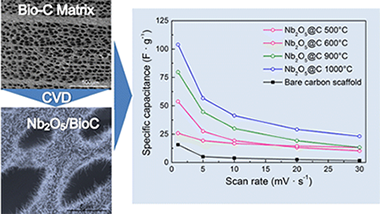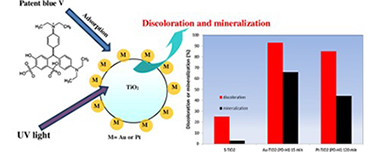Artículos SCI
2016
2016
Materiales de Diseño para la Energía y Medioambiente
Electrochemical Energy Storage Applications of CVD Grown Niobium Oxide Thin Films
Fiz, Raquel; Appel, Linus; Gutierrez-Pardo, Antonio; Ramirez-Rico, Joaquin; Mathur, SanjayACS Applied Materials & Interfaces, 8 (2016) 21423–21430
Show abstract ▽

We report here on the controlled synthesis, characterization, and electrochemical properties of different polymorphs of niobium pentoxide grown by CVD of new single-source precursors. Nb2O5 films deposited at different temperatures showed systematic phase evolution from low-temperature tetragonal (TT-Nb2O5, T-Nb2O5) to high temperature monoclinic modifications (H–Nb2O5). Optimization of the precursor flux and substrate temperature enabled phase-selective growth of Nb2O5 nanorods and films on conductive mesoporous biomorphic carbon matrices (BioC). Nb2O5 thin films deposited on monolithic BioC scaffolds produced composite materials integrating the high surface area and conductivity of the carbonaceous matrix with the intrinsically high capacitance of nanostructured niobium oxide. Heterojunctions in Nb2O5/BioC composites were found to be beneficial in electrochemical capacitance. Electrochemical characterization of Nb2O5/BioC composites showed that small amounts of Nb2O5 (as low as 5%) in conjunction with BioCarbon resulted in a 7-fold increase in the electrode capacitance, from 15 to 104 F g–1, while imparting good cycling stability, making these materials ideally suited for electrochemical energy storage applications.
Agosto, 2016 | DOI: 10.1021/acsami.6b03945
Reactividad de Sólidos
On the Multicycle Activity of Natural Limestone/Dolomite for Thermochemical Energy Storage of Concentrated Solar Power
Sarrion, B; Valverde, JM; Perejon, A; Perez-Maqueda, L; Sanchez-Jimenez, PEEnergy Technology, 4 (2016) 1013-1019
Show abstract ▽
Cheap, efficient, and non-toxic energy storage technologies are urgently needed to handle the rapidly increasing penetration of intermittent renewable energies into the grid. This work explores the use of limestone and dolomite for energy storage in concentrated solar power (CSP) plants by means of the calcium looping (CaL) process based on the multicycle carbonation/calcination of CaO. An efficient integration of the CaL process into CSP plants involves high temperature carbonation and calcination at moderate temperatures in a close CO2 cycle for power generation. These conditions differ from those of the CaL process for CO2 capture, which lead to CaO deactivation as extensively reported in recent years. In contrast, we show that limestone- and dolomite-derived CaO give rise to a high residual conversion at CaL-CSP conditions and in short residence times, which would facilitate the development of a competitive and clean CSP technology with permanent energy storage.
Agosto, 2016 | DOI: 10.1002/ente.201600068
Materiales Ópticos Multifuncionales
Modified emission of extended light emitting layers by selective coupling to collective lattice resonances
Ramezani, Mohammad; Lozano, Gabriel; Verschuuren, Marc A.; Gomez-Rivas, JaimePhysical Review B, 94 (2016) 12
Show abstract ▽

We demonstrate that the coupling between light emitters in extended polymer layers and modes supported by arrays of plasmonic particles can be selectively enhanced by accurate positioning of the emitters in regions where the electric field intensity of a given mode is maximized. The enhancement, which we measure to reach up to 70%, is due to the improved spatial overlap and coupling between the optical mode and emitters. This improvement of the coupling leads to a modification of the emission spectrum and the luminous efficacy of the sample.
Agosto, 2016 | DOI: 10.1103/PhysRevB.94.125406
Materiales Coloidales
Confinement and surface effects on the physical properties of rhombohedral-shape hematite (alpha-Fe2O3) nanocrystals
Luna, C; Cuan-Guerra, AD; Barriga-Castro, ED; Nunez, NO; Mendoza-Resendez, RMaterials Research Bulletin, 80 (2016) 44-52
Show abstract ▽

Morphological, microstructural and vibrational properties of hematite (alpha-Fe2O3) nanocrystals with a rhombohedral shape and rounded edges, obtained by forced hydrolysis of iron(III) solutions under a fast nucleation, have been investigated in detail as a function of aging time. These studies allowed us to propose a detailed formation mechanism and revealed that these nanocrystals are composed of four {104} side facets, two {110} faces at the edges of the long diagonal of the nanocrystals and two {-441} facets as the top and bottom faces. Also, the presence of nanoscopic pores and fissures was evidenced. The vibrational bands of such nanocrystals were shifted to lower frequencies in comparison with bulk hematite ones as the nanocrystal size was reduced due to phonon confinement effects. Also, the indirect and direct transition band gaps displayed interesting dependences on the aging time arising from quantum confinementand surface effects
Agosto, 2016 | DOI: 10.1016/j.materresbull.2016.03.029
Fotocatálisis Heterogénea: Aplicaciones
Photocatalytic removal of patent blue V dye on Au-TiO2 and Pt-TiO2 catalysts
Vaiano, V; Iervolino, G; Sannino, D; Murcia, JJ; Hidalgo, MC; Ciambelli, P; Navio, JAApplied Catalysis B: Environmental, 188 (2016) 134-146
Show abstract ▽

In this work it was studied the efficiency of a photocatalytic process for the removal of patent blue V. This dye is very difficult to remove by conventional treatments such as adsorption or coagulation therefore the photocatalytic process is a very interesting alternative for the removal this dye mainly because it does not require expensive oxidants and it can be carried out at mild temperatures and pressures. In this work it was tested the efficiency of Au-TiO2 and Pt-TiO2 photocatalysts in the Patent blue V removal. The Au-TiO2 catalysts were prepared by two different methods: chemical reduction and photochemical deposition; Pt-TiO2 catalysts were obtained only by photochemical deposition. In the synthesis of the catalysts prepared by photochemical deposition, it was evaluated the influence of some parameters, such as deposition time and the intensity of the light source over the physicochemical properties and photocatalytic activity of the materials obtained. An analysis of the effect of the catalyst dosage and initial patent blue V concentration over the dye degradation efficiency was also attempted.
In general, it was observed that the presence of Au or Pt on TiO2 enhances the patent blue V photodegradation; it was found that noble metal particle size and distribution on TiO2 surface are important factors influencing the dye removal. The highest dye degradation was obtained over the Au-TiO2 catalyst prepared by photochemical deposition, using high light intensity and 15 min of deposition time during the synthesis. A discoloration and a total organic carbon (TOC) removal of 93 and 67% respectively, were obtained over this material after 180 min of UV irradiation. These values are higher than that the obtained on S-TiO2 (discoloration and TOC removal of about 25% and 3%, respectively).
Julio, 2016 | DOI: 10.1016/j.apcatb.2016.02.001
- ‹ anterior
- 217 of 420
- siguiente ›














